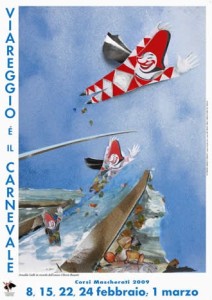 In February 1873, around the coffee tables of the Casino, the idea of a parade of floats to celebrate the carnival – in the open, in the square among the people – blossomed among the young well-to-do of Viareggio of that time. Mardì Gras, 1873 – the Viareggio Carnival, as it is known today, was born: a spectacular event among the finest and grandest in the world.
In February 1873, around the coffee tables of the Casino, the idea of a parade of floats to celebrate the carnival – in the open, in the square among the people – blossomed among the young well-to-do of Viareggio of that time. Mardì Gras, 1873 – the Viareggio Carnival, as it is known today, was born: a spectacular event among the finest and grandest in the world.
Toward the end of the century, in the midst of the people’s festival, immediately great, the triumphal floats appeared; true and proper monuments, build in wood, plaster, and jute; modelled by sculptors and put together by carpenters and iron smiths who, in Darsena, on the ladders of the naval dockyards, knew how to built ships able to challenge the tricky waters and capricious winds of the oceans. From then on, the floats built from year to year have navigated through a sea of amazed and amused people.
The First World War seemed to destroy, together with the belle époque in Europe, even the Viareggio Carnival. Yet the event emerged from these difficult times to flourish in 1921 with even more splendor and more grandeur when the floats paraded through two marvellous avenues, running parallel to each other and the beach. These avenues, the mythical coastal promenade backed by rolling hills and the Apuane Alps, became in the summer the meeting point of national and international society life, a natural and grand scene of incomparable beauty where the carnival constructions were shown off, livelier and more animated each year. In 1921, the first official song, the “Cup of Champagne” was sung, and is now the traditional song of the Carnival. Even the figures became animated to the sound of music for the first time, since the band found a place on board a float called “Tonin di Burio”, which represented a wedding feast in the yard of a farmhouse. Two years later the “Pierrot”, the nostalgic and romantic figure of the Carnival, was the first Carnival figure to move head and eyes. In 1925, through the initiative of some builders, papier-mâché was introduced to create the floats, and from then on has allowed colossal but very light constructions, enormous figures able to hover in the air, challenging the laws of gravity. With this novelty, you could say that the history of the Viareggio Carnival became a legend, thanks to the builders who, because of their creative capacity, were called “papier-mâché wizards” by the national and international press.
In 1930, Uberto Bonetti the painter, who had illustrated the magic of the Carnival with official posters, created Burlamacco, the now famous figure, that in the spectacle of 1931, on the background of piers projecting into the sea, appeared in the company of Ondina. Today, Burlamacco has a place among the Italian Carnival figures in Rome at the Folklore and Tradition museum and is on exhibition in Paris at the Musée de l’Homme. After the Second World War, the Carnival resumed in 1946. Since then, King Carnival has strengthened his sceptre, passing unharmed – in June 1960 – through a frightening fire in the hangars where floats are made. Since the beginning (1954), first national TV and then Eurovision (1958) have aired the spectacular show, taking the Viareggio Carnival everywhere by satellite. As always, each year, a long line-up of well-known guests, politicians, and sports and show business personalities, have come to Viareggio to admire their effigies in papier-mâché, just as hundreds of thousands of people have made this great spectacle a success. The Viareggio Carnival celebrated its 125th year in 1998 with the splendour of an entire month of celebrations day and night. Strengthened by its continued success, this historic event continued to grow with spectacular celebrations that icnluded floats, parades, parties in all the districts, masked balls, reviews of every type and, first among these, the youth football tournament the “Carnival Cup”.
Since 2002 the Viareggio Carnival has been named Italian and European Carnival. Every year for four weeks daily and nightly celebrations take place with floats, parades, district celebrations, masked dances, and shows of every kind. 2001 was a particularly memorable date in the history of the Viareggio Carnival as the new “Citadel” (Carnival town) was inaugurated: a multi-use feat of architecture that includes new hangars for the creation of the floats, the papier-mâché school, and a great arena where “Citadel under the Stars” takes place during the summer, a festival of shows, concerts, and cultural events. The Carnival museum will soon be integrated with the Citadel to provide a multimedia showcase for the historical and cultural memory of the Viareggio Carnival and other Carnival celebrations throughout the world.
Viareggio Carnival is the ideal place to encounter different people and cultures, thanks to the media coverage, the chance to globalize this event which mixes tradition with universal principles as solidarity and peace.
Every year many people arrive in Viareggio. Come and join us!
Courtesy of the Fondazione Carnevale di Viareggio
For a complete schedule of events, visit the Carnevale di Viareggio website at www.viareggio.ilcarnevale.com
 Add to favorites
Add to favorites
Connect